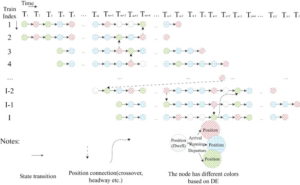Rail network is a crucial network which has to be made efficient. The increasing density of population needs to be considered as a key factor in the entire railways network. The train timetable scheduling can have defects because of large number of trains and passengers which cause real time traffic delays. Such delays can be prevented with a better evaluation and identification of the rail system performance. This can be done by considering a Train State Graph (TSG).

A train state graph is a directed graph with horizontal axis as time stamp and vertical axis as train index. The time stamp shows an occurrence of an event such as arrival, departure, delay, braking. Each nodes represents a unique state of a train. The vertices in the graph shows the transition of train. As suggested in the paper, we can set a constant time step (e.g. 50 s), so that the longest time interval between two discrete events is the constant time step. This would help to analyze events but will not be effective if the time constant is too small or too big. A solution to this problem is to mark the delays caused by major events and then remove them and decrease the delay for future. In other words, simply identify and try to eliminate the root causes of the delay.
Source:
https://doi.org/10.1080/0305215X.2017.1284832
